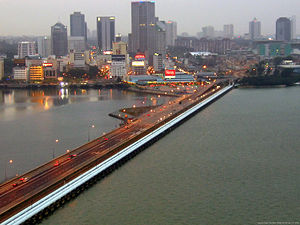| This article needs additional citations for verification. Please help improve this article by adding citations to reliable sources. Unsourced material may be challenged and removed. Find sources: "Straits of Johor" – news · newspapers · books · scholar · JSTOR (December 2010) (Learn how and when to remove this message) |
| Straits of Johor | |
|---|---|
 The strait is located between Singapore and Malaysia The strait is located between Singapore and Malaysia | |
| Coordinates | 1°26′48″N 103°45′13″E / 1.44667°N 103.75361°E / 1.44667; 103.75361 |
| Type | Strait |
| Basin countries | Singapore Malaysia |


The Johor Strait (also known as the Tebrau Strait, Straits of Johor, Selat Johor, Selat Tebrau, and Tebrau Reach, also spelled Johore Strait) is an international strait in Southeast Asia, between Singapore and Peninsular Malaysia.
Geography
The strait separates the Malaysian state of Johor on the mainland Malay Peninsula to the north, from Singapore and its islands on the south. It connects to the Strait of Malacca on the west, and the Singapore Strait on the southeast.
The mouth and delta of the Johor River is on its northeast side in Malaysia.
Crossings
See also: Johor–Singapore Causeway and Malaysia–Singapore Second LinkThere are currently two bridges crossing the strait. The Johor–Singapore Causeway, known simply as "The Causeway", links Johor Bahru and Woodlands in Singapore. The Malaysia–Singapore Second Link bridge is further west over the strait, links Iskandar Puteri in Malaysia and Tuas in Singapore.
In 2003, Malaysia wanted to build a bridge across the strait to replace the existing causeway, but negotiations with Singapore were not successful. The main reasons cited for the change were:
- a bridge would allow free flow of water across both sides of the strait which were artificially cut in two with the building of the causeway before (this would allow ships to bypass the port of Singapore).
- a bridge would help ease congestion in Johor Bahru.
In August 2003, Malaysia announced that it was going ahead with a plan to build a gently sloping, curved bridge that would join up with Singapore's half of the existing causeway. The plans included a swing bridge for the railway line. However, plans to build the bridge have been called off by Malaysia as of 2006 after Singapore said it was amenable to the bridge if the negotiations include other bilateral matters such as the use of Malaysian airspace by Singapore's air force and the buying of water and sand resources from Malaysia. Malaysia viewed Singapore's proposal as a compromise on its sovereignty.
Other proposed crossings include Johor Bahru–Singapore Rapid Transit System and Kuala Lumpur–Singapore high-speed rail. Both of which would have started construction in 2019, but have since been delayed due to the change of political administration in Malaysia in 2018 and the ongoing efforts to reduce national debts incurred previously under Najib Razak's administration.
Tributaries
Major tributaries which empty into the Strait of Johore include:
- Johor River
- Pelentong River
- Pulai River
- Segget River
- Tebrau River
- Sungai Sengkuang
- Sungai Haji Rahmat
- Sungai Kempas
- Sungai Sri Buntan
- Sungai Abd Samad
- Sungai Air Molek
- Sungai Stulang
- Sungai Setanggong
- Sungai Tampoi
- Sungai Sebulong
- Sungai Bala
- Sungai Pandan
- Sungai Tengkorak
- Sungai Senibong
In the Malay language, Sungai is the word for river.
Ecology
Pollution along the Johore Strait is notable.
The area is also a source of environmental contention between Malaysia and Singapore, due to land reclamation projects on both sides of the Causeway. There have been suggestions that the ongoing land reclamation projects may impact the maritime boundary, shipping lanes, and water ecology of the Malaysian side. Environmental Impact Assessments are requested before any reclamation is carried out such as the Forest City project.
Reclamation projects may also endanger the habitat and food source of dugongs, which are native to the strait.
History
The Johore Strait is the location of two Victoria Cross deeds. The award was for Lieutenant Ian Edward Fraser and Acting Leading Seaman James Joseph Magennis for the sinking of the 9,850-tonne Japanese cruiser Takao on 31 July 1945.
Places of interest
A well known tourist attraction of the Strait of Johore's is Lido Beach, located on the Malaysian side in Johor Bahru. Here, visitors can walk or cycle along the 2 km stretch of the beach. There are numerous restaurants and food stalls.
References
- Singapore objected to bridge to replace Causeway
- Shannon Teoh (2015-04-13). "Najib, Mahathir on 'crooked bridge': What is the issue about". The Straits Times. Retrieved 2019-03-20.
- "Govt: Declassified documents 'put the record straight' on bridge issue - Nation | The Star Online". www.thestar.com.my. Retrieved 2019-03-20.
- Nur Asyiqin Mohamad Salleh (2018-05-31). "JB-Singapore RTS link still on, says minister". The Straits Times. Retrieved 2019-08-24.
- "KL-Singapore High-Speed Rail formally postponed; service targeted to start by Jan 2031". CNA. Retrieved 2019-08-24.
- "Clean-up of Johor Straits to begin in September". AsiaOne. 16 Jun 2008. Archived from the original on 2 March 2016. Retrieved 18 February 2016.
- Chong, Zi Liang. "Singapore concerned over Johor Strait projects". AsiaOne. Retrieved 18 February 2016.
- "Press Releases". MINISTRY OF THE ENVIRONMENT AND WATER RESOURCES. Retrieved 18 February 2016.
- "No. 37346". The London Gazette (Supplement). 9 November 1945. pp. 5529–5530.
- "Reclaimed land in JB caves in". The Star. 14 Nov 2010. Archived from the original on 2 March 2016. Retrieved 18 February 2016.
- "Malaysian workers use risky shortcut to evade Causeway jam". Sin Chew Daily. 21 Jun 2015. Archived from the original on June 22, 2015. Retrieved 18 February 2016.
External links
![]() Media related to Straits of Johor at Wikimedia Commons
Media related to Straits of Johor at Wikimedia Commons